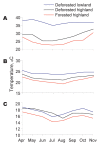Deforestation and vectorial capacity of Anopheles gambiae Giles mosquitoes in malaria transmission, Kenya
- PMID: 18826815
- PMCID: PMC2573462
- DOI: 10.3201/eid1410.070781
Deforestation and vectorial capacity of Anopheles gambiae Giles mosquitoes in malaria transmission, Kenya
Abstract
We investigated the effects of deforestation on microclimates and sporogonic development of Plasmodium falciparum parasites in Anopheles gambiae mosquitoes in an area of the western Kenyan highland prone to malaria epidemics. An. gambiae mosquitoes were fed with P. falciparum-infected blood through membrane feeders. Fed mosquitoes were placed in houses in forested and deforested areas in a highland area (1,500 m above sea level) and monitored for parasite development. Deforested sites had higher temperatures and relative humidities, and the overall infection rate of mosquitoes was increased compared with that in forested sites. Sporozoites appeared on average 1.1 days earlier in deforested areas. Vectorial capacity was estimated to be 77.7% higher in the deforested site than in the forested site. We showed that deforestation changes microclimates, leading to more rapid sporogonic development of P. falciparum and to a marked increase of malaria risk in the western Kenyan highland.
Figures


References
-
- Round-Turner D. Kakamega Forest, the official guide. Nairobi (Kenya): Kenya Indigenous Forest Conservation Programme; 1994.
-
- Brooks TM, Pimm SL, Oyugi JO. Time lag between deforestation and bird extinction in tropical forest fragments. Conserv Biol. 1999;13:1140–50. 10.1046/j.1523-1739.1999.98341.x - DOI
-
- Food and Agricultural Organization. Forest resources assessment, 1990: tropical countries. FAO forestry paper no. 112. Rome: The Organization; 1993.
-
- Bodker R, Akida J, Shayo D, Kisinza W, Msangeni HA, Pedersen EM, et al. Relationship between altitude and intensity of malaria transmission in the Usambara Mountains, Tanzania. J Med Entomol. 2003;40:706–17. - PubMed
Publication types
MeSH terms
Grants and funding
LinkOut - more resources
Full Text Sources
Other Literature Sources
